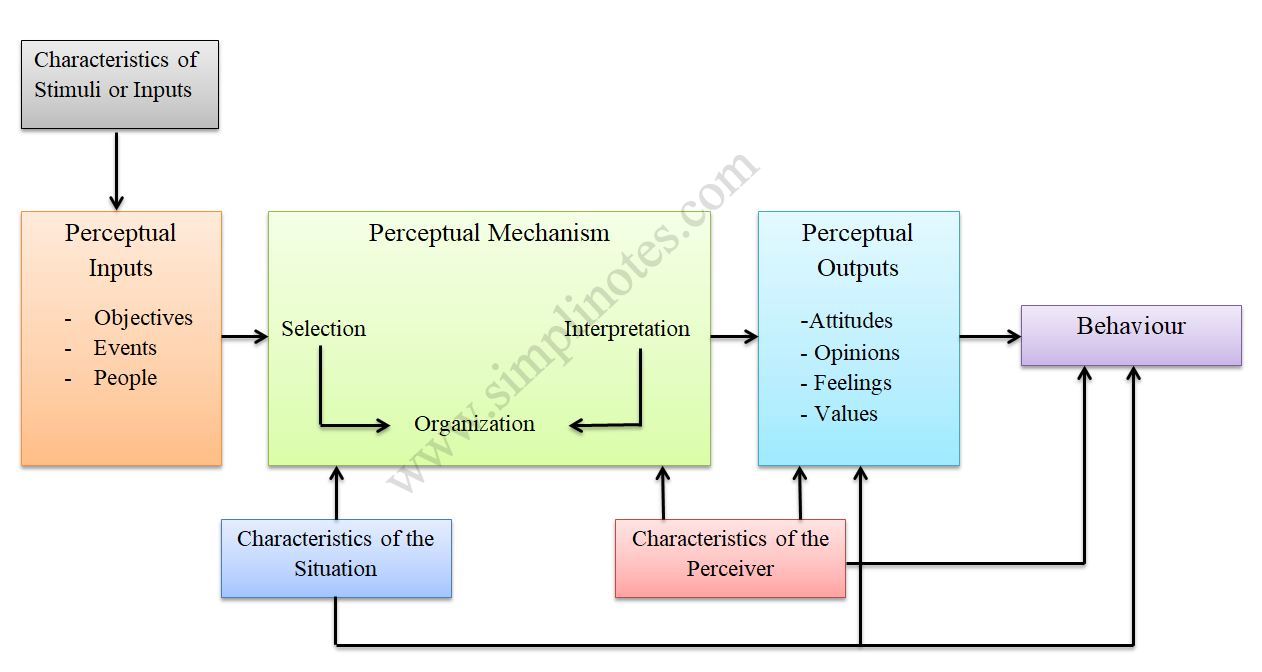Perceptual Process
Perception is a process consisting of several sub-processes. We can take an input-throughput- output approach to understand the dynamics of the perceptual process. This approach emphasizes that there is input which is processed and give output. The stimuli in the environment-subjects, events, or people can be considered as the perceptual inputs. The actual transformation of these inputs through the perceptual mechanisms of selection, organization, and interpretation can be treated as the throughputs, and the resultant opinions, feelings, attitudes, etc., which ultimately influence or behaviour, can be viewed as the perceptual outputs.
Following is a simplified version of perceptual process. It does not present the whole factors which go in input-throughput-output process of perception.
Perception as a complex process presents three basic sub processes or elements of perception. These are existence of stimuli, perceptual mechanism, and perceptual outputs. Perceptual outputs along with other determinants of human behaviour affect and shape behaviour. Let us see how perceptual process works in terms of its three basic elements.
I. Perceptual Inputs
Strictly speaking, perceptual inputs in the form of stimuli are not the part of actual perceptual process though these are necessary for the occurrence of perception. Stimuli may be in the form of objects, events, or people. Thus, everything in the setting where events occur, or which contributes to the occurrence of events, can be termed as perceptual input. Further, the characteristics of stimuli are important as these affect the extent to which the perceiver is attracted to these which affects the selection of stimuli for perception along with other variables affecting selection of stimuli like perceiver’s characteristics and situational variables. When the perceiver interacts with a stimulus, sensation takes place which, we have seen earlier, starts perceptual process.
II. Perceptual Mechanism
Perceptual mechanism involves three elements—selection of stimuli, organization of stimuli, and interpretation of stimuli.
1. Selection of Stimuli
After receiving the stimuli from the environment, some are selected for further processing while others are screened out because It Is not possible for a person to select all stimuli which he sees in the environment. There are two types of factors which affect selection of stimuli. These are external and related to stimuli and internal related to the perceiver.
2. Organization of Stimuli
After the stimuli are received, these are organized in some form in order to make sense out of that. The various forms of organizing stimuli are figure-ground, perceptual grouping, simplification, and closure. We shall discuss the Impact of these factors on perception in the section that follows perceptual selectivity.
3. Interpretation of Stimuli
The perceptual inputs that have been organized will have to be interpreted by the perceiver so that he can sense and extract some meaning of what is going on in the situation. People interpret the meaning of what they have selectively perceived and organized fit terms of their own assumptions of people, things, and situations. They also become judgmental as well and tend to interpret the things as good/bad, beautiful/ugly, and so on which are quite relative terms. In such a process, there are chances of misinterpretation. Interpretation of stimuli is affected by characteristics of stimuli, situations under which perception takes place, and characteristics of the perceiver. These factors also affect the total perceptual process. For example, as discussed earlier, the characteristics of stimuli affect their selection for perception. At the same time, these may affect the interpretation also. Similarly, the physical, social, and organizational settings in which an object is perceive , so affect the interpretation. In interpreting the stimuli, the perceiver may commit mistake in perceiving because of several reasons.
III. Perceptual Outputs
Based on perceptual mechanism which ends with interpretation of stimuli, perceptual outputs emerge. These outputs may be in the form of covert actions like development of attitudes, opinions, beliefs, impression about the stimuli under consideration. These outputs along with other factors affecting human behaviour may result in overt behaviour. For overt behaviour to occur, perception is not the sole decider though it is important. For example, when a person sees an advertisement of a product (stimulus), he may perceive that the product is good. This perception, however, may not be enough for the person to buy the product (overt behaviour). The actual buying may depend on the availability of the product, perceiver’s need for product, and his propensity and capacity to spend money for buying the product.


